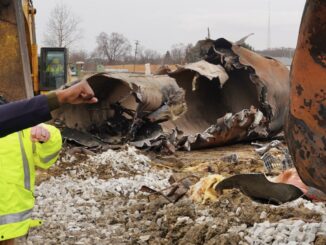Preliminary Report: February 23, 2023
On February 3, 2023, about 8:54 p.m. local time, eastbound Norfolk Southern Railway (NS) general merchandise freight train 32N derailed 38 railcars on main track 1 of the NS Fort Wayne Line of the Keystone Division in East Palestine, Ohio. [1] (See figure.) The derailed equipment included 11 tank cars carrying hazardous materials that subsequently ignited, fueling fires that damaged an additional 12 non-derailed railcars. First responders implemented a 1-mile evacuation zone surrounding the derailment site that affected up to 2,000 residents. There were no reported fatalities or injuries. At the time of the accident, visibility conditions were dark and clear; the weather was 10°F with no precipitation.
Train 32N comprised 2 head-end locomotives, 149 railcars, and 1 distributed power locomotive located between railcars 109 and 110. The consist included 20 placarded hazardous materials tank cars transporting combustible liquids, flammable liquids, and flammable gas, including vinyl chloride. [2] Train 32N was traveling about 47 mph at the time of the derailment, which was less than the maximum authorized timetable speed of 50 mph. [3] Train movements near the derailment site are authorized by cab signals and wayside signal indications with an overlaid positive train control system and are coordinated by the NS Cleveland East train dispatcher located in Atlanta, Georgia. The positive train control system was enabled and operating at the time of the derailment.
Train 32N was operating with a dynamic brake application as the train passed a wayside defect detector on the east side of Palestine, Ohio, at milepost (MP) 49.81. [4] The wayside defect detector, or hot bearing detector (HBD), transmitted a critical audible alarm message instructing the crew to slow and stop the train to inspect a hot axle. The train engineer increased the dynamic brake application to further slow and stop the train. During this deceleration, an automatic emergency brake application initiated, and train 32N came to a stop.
On the Fort Wayne Line of the Keystone Division, NS has equipped their rail network with HBD systems to assess the temperature conditions of wheel bearings while en route. The function of the HBD is to detect overheated bearings and provide audible real-time warnings to train crews. Train 32N passed three HBD systems on its trip before the derailment. At MP 79.9, the suspect bearing from the 23rd car had a recorded temperature of 38°F above ambient temperature. When train 32N passed the next HBD, at MP 69.01, the bearing’s recorded temperature was 103°F above ambient. The third HBD, at MP 49.81, recorded the suspect bearing’s temperature at 253°F above ambient. NS has established the following HBD alarm thresholds (above ambient temperature) and criteria for bearings:
- Between 170°F and 200°F, warm bearing (non-critical); stop and inspect
- A difference between bearings on the same axle greater than or equal to 115°F (non-critical); stop and inspect
- Greater than 200°F (critical); set out railcar
After the train stopped, the crew observed fire and smoke and notified the Cleveland East dispatcher of a possible derailment. With dispatcher authorization, the crew applied handbrakes to the two railcars at the head of the train, uncoupled the head-end locomotives, and moved the locomotives about 1 mile from the uncoupled railcars. Responders arrived at the derailment site and began response efforts.
On February 5, responders mitigated the fire, but five derailed DOT-105 specification tank cars (railcars 28–31 and 55) carrying 115,580 gallons of vinyl chloride continued to concern authorities because the temperature inside one tank car was still rising. This increase in temperature suggested that the vinyl chloride was undergoing a polymerization reaction, which could pose an explosion hazard. Responders scheduled a controlled venting of the five vinyl chloride tank cars to release and burn the vinyl chloride, expanded the evacuation zone to a 1-mile by 2-mile area, and dug ditches to contain released vinyl chloride liquid while it vaporized and burned. The controlled venting began about 4:40 p.m. on February 6 and continued for several hours.
While on scene, National Transportation Safety Board (NTSB) investigators examined railroad equipment and track conditions; reviewed data from the signal system, wayside defect detectors, local surveillance cameras, and the lead locomotive’s event recorder and forward-facing and inward-facing image recorders; and completed interviews. NTSB investigators identified and examined the first railcar to derail, the 23rd railcar in the consist. Surveillance video from a local residence showed what appeared to be a wheel bearing in the final stage of overheat failure moments before the derailment. The wheel bearing and affected wheelset have been collected as evidence and will be examined by the NTSB. The vinyl chloride tank car top fittings, including the relief valves, were also removed and examined by the NTSB on scene. The top fittings will be shipped to Texas for testing under the direction of the NTSB.
The hazardous material tank cars have been decontaminated. NTSB investigators returned to Ohio on February 21, 2023, to examine each hazardous material tank car, document damage, and secure evidence for laboratory analysis.
The NTSB’s investigation is ongoing. Future investigative activity will focus on the wheelset and bearing; tank car design and derailment damage; a review of the accident response, including the venting and burning of the vinyl chloride; railcar design and maintenance procedures and practices; NS use of wayside defect detectors; and NS railcar inspection practices.
The NTSB is not involved in air monitoring, testing of water quality, environmental remediation, or evacuation orders. Questions on environmental issues should be referred to the Environmental Protection Agency.
Parties to the investigation include the Pipeline and Hazardous Materials Safety Administration, the Federal Railroad Administration, Ohio State Highway Patrol, the Village of East Palestine, Norfolk Southern Railway, Trinity Industries Leasing Company, GATX Corporation, the Brotherhood of Railway Carmen, the International Association of Sheet Metal, Air, Rail and Transportation Workers, the Brotherhood of Locomotive Engineers and Trainmen, and the International Association of Fire Fighters.
[1] (a) All times in this report are local time. (b) Train 32N was traveling from Madison, Illinois, to Conway, Pennsylvania.
Investigative Update: 14 February 2023
The NTSB investigation of the Feb. 3 Norfolk Southern freight train derailment in East Palestine, Ohio is ongoing.
On Feb. 3, at approximately 8:54 p.m., local time, eastbound Norfolk Southern Railway, general merchandise freight train 32N, derailed on main track 1 in East Palestine, Ohio. As a result of the derailment, 38 rail cars derailed and a fire ensued which damaged an additional 12 cars. There were 20 total hazardous material cars in the train consist—11 of which derailed. A list of what the derailed rail cars were carrying is available online. There were no reported fatalities or injuries.
NTSB is conducting a safety investigation to determine the probable cause of the derailment and issue any safety recommendations, if necessary, to prevent future derailments. The NTSB can also issue urgent recommendations at any point during the investigation. All questions regarding the safety investigation should go to NTSB. While emergency response will be a factor in the investigation, NTSB is not involved in air monitoring, testing of water quality, environmental remediation or the evacuation orders. Questions on environmental issues should be referred to the Environmental Protection Agency. Learn more: East Palestine Train Derailment – EPA OSC Response.
Parties to the NTSB investigation provide technical assistance. They include: U.S. Department of Transportation’s Pipeline and Hazardous Materials Safety Administration and Federal Railroad Administration, Ohio State Highway Patrol, the Village of East Palestine, Norfolk Southern Railway, Trinity Industries Leasing Company, GATX Corporation, Brotherhood of Railway Carmen, International Association of Sheet Metal, Air, Rail and Transportation Workers and Brotherhood of Locomotive Engineers and Trainmen.
NTSB continues to work with the investigative parties to determine what exactly caused the derailment and to evaluate the emergency response efforts.
NTSB investigators have identified and examined the rail car that initiated the derailment. Surveillance video from a residence showed what appears to be a wheel bearing in the final stage of overheat failure moments before the derailment. The wheelset from the suspected railcar has been collected as evidence for metallurgical examination. The suspected overheated wheel bearing has been collected and will be examined by engineers from the NTSB Materials Laboratory in Washington, D.C.
The tank cars are currently being decontaminated. Once the process is complete, NTSB investigators will return to Ohio to complete a thorough examination of the tank cars.
The vinyl chloride tank car top fittings, including the relief valves, were removed and secured in a locked intermodal container pending an NTSB examination. Once the fittings are examined by NTSB investigators, they will be shipped to Texas for testing, which will be conducted under the direction of the NTSB.
NTSB has obtained locomotive event recorder data, forward- and inward-facing image recording data and wayside defect detector data. NTSB investigators continue to review documentation, event recorder data and perform interviews. A preliminary report is expected to publish in two weeks.
While on scene, NTSB Member Michael Graham hosted two press briefing on Feb. 4 and Feb. 5, which are available on NTSB’s YouTube channel. B-Roll is also available on YouTube.
Release date: 6 February 2023
We have initiated an investigation into a derailment of Norfolk Southern freight with hazardous materials that caused a fire in East Palestine, OH on February 3, 2023.




